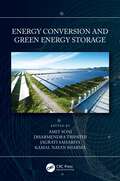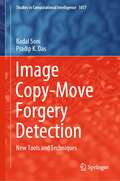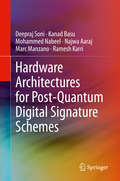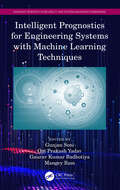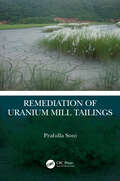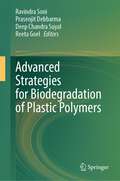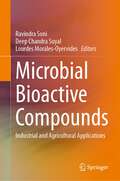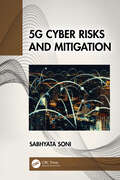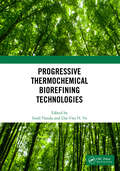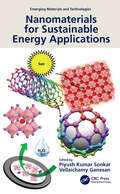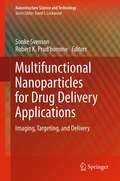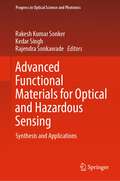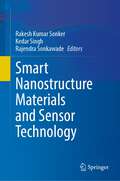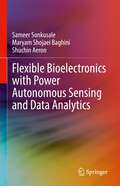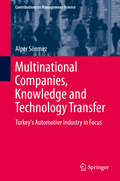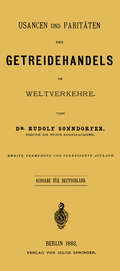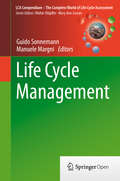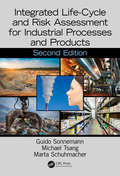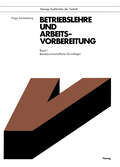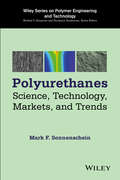- Table View
- List View
Energy Conversion and Green Energy Storage
by Amit SoniEnergy Conversion and Green Energy Storage presents recent developments in renewable energy conversion and green energy storage. Covering technical expansions in renewable energy and applications, energy storage, and solar photovoltaics, the book features chapters written by global experts in the field. Providing insights related to various forms of renewable energy, the book discusses developments in solar photovoltaic applications. The book also includes simulation codes and programs, such as Wien2k code, VASP code, and MATLAB®. The book serves as a useful reference for researchers, graduate students, and engineers in the field of energy.
Energy Conversion and Green Energy Storage
by Amit Soni Dharmendra Tripathi Jagrati Sahariya Kamal Nayan SharmaEnergy Conversion and Green Energy Storage presents recent developments in renewable energy conversion and green energy storage. Covering technical expansions in renewable energy and applications, energy storage, and solar photovoltaics, the book features chapters written by global experts in the field. Providing insights related to various forms of renewable energy, the book discusses developments in solar photovoltaic applications. The book also includes simulation codes and programs, such as Wien2k code, VASP code, and MATLAB®. The book serves as a useful reference for researchers, graduate students, and engineers in the field of energy.
Image Copy-Move Forgery Detection: New Tools and Techniques (Studies in Computational Intelligence #1017)
by Badal Soni Pradip K. DasThis book presents a detailed study of key points and block-based copy-move forgery detection techniques with a critical discussion about their pros and cons. It also highlights the directions for further development in image forgery detection. The book includes various publicly available standard image copy-move forgery datasets that are experimentally analyzed and presented with complete descriptions. Five different image copy-move forgery detection techniques are implemented to overcome the limitations of existing copy-move forgery detection techniques. The key focus of work is to reduce the computational time without adversely affecting the efficiency of these techniques. In addition, these techniques are also robust to geometric transformation attacks like rotation, scaling, or both.
Hardware Architectures for Post-Quantum Digital Signature Schemes
by Deepraj Soni Kanad Basu Mohammed Nabeel Najwa Aaraj Marc Manzano Ramesh KarriThis book explores C-based design, implementation, and analysis of post-quantum cryptography (PQC) algorithms for signature generation and verification. The authors investigate NIST round 2 PQC algorithms for signature generation and signature verification from a hardware implementation perspective, especially focusing on C-based design, power-performance-area-security (PPAS) trade-offs and design flows targeting FPGAs and ASICs.Describes a comprehensive set of synthesizable c code base as well as the hardware implementations for the different types of PQC algorithms including lattice-based, code-based, and multivariate-based;Demonstrates the hardware (FPGA and ASIC) and hardware-software optimizations and trade-offs of the NIST round 2 signature-based PQC algorithms;Enables designers to build hardware implementations that are resilient to a variety of side-channels.
Intelligent Prognostics for Engineering Systems with Machine Learning Techniques (Advanced Research in Reliability and System Assurance Engineering)
by Gunjan Soni Om Prakash Yadav Gaurav Kumar Badhotiya Mangey RamThe text discusses the latest data-driven, physics-based, and hybrid approaches employed in each stage of industrial prognostics and reliability estimation. It will be a useful text for senior undergraduate, graduate students, and academic researchers in areas such as industrial and production engineering, electrical engineering, and computer science. The book Discusses basic as well as advance research in the field of prognostics. Explores integration of data collection, fault detection, degradation modeling and reliability prediction in one volume. Covers prognostics and health management (PHM) of engineering systems. Discusses latest approaches in the field of prognostics based on machine learning. The text deals with tools and techniques used to predict/ extrapolate/ forecast the process behavior, based on current health state assessment and future operating conditions with the help of Machine learning. It will serve as a useful reference text for senior undergraduate, graduate students, and academic researchers in areas such as industrial and production engineering, manufacturing science, electrical engineering, and computer science.
Intelligent Prognostics for Engineering Systems with Machine Learning Techniques (Advanced Research in Reliability and System Assurance Engineering)
by Gunjan Soni Om Prakash Yadav Gaurav Kumar Badhotiya Mangey RamThe text discusses the latest data-driven, physics-based, and hybrid approaches employed in each stage of industrial prognostics and reliability estimation. It will be a useful text for senior undergraduate, graduate students, and academic researchers in areas such as industrial and production engineering, electrical engineering, and computer science. The book Discusses basic as well as advance research in the field of prognostics. Explores integration of data collection, fault detection, degradation modeling and reliability prediction in one volume. Covers prognostics and health management (PHM) of engineering systems. Discusses latest approaches in the field of prognostics based on machine learning. The text deals with tools and techniques used to predict/ extrapolate/ forecast the process behavior, based on current health state assessment and future operating conditions with the help of Machine learning. It will serve as a useful reference text for senior undergraduate, graduate students, and academic researchers in areas such as industrial and production engineering, manufacturing science, electrical engineering, and computer science.
Remediation of Uranium Mill Tailings
by Prafulla SoniThis book covers issues pertaining to uranium tailings with special reference to consolidation of radioactivity including systematic ecological strategy for consolidation of radionuclides in uranium tailings. It discusses sustainable consolidation of radioactivity and checks the migration of unextracted uranium from tailing piles to plants and atmosphere supported by a case study from a uranium mine. It provides simple ecological solutions for the remediation of radioactivity in mill tailings. Features: Provides insight into the application of applied ecology for bioremediation of radioactive wastes. Discusses species selection criteria for tailings radioactivity consolidation. Explains safe treatment of the tailings of radioactive ore processing plants. Illustrates the role of ethnobotany in the selection of the most appropriate species to effectively use in bioremediation. Focuses on experimental outcomes. This book is aimed at researchers and professionals in mining engineering, applied geology, nuclear tailings and environmental protection.
Remediation of Uranium Mill Tailings
by Prafulla SoniThis book covers issues pertaining to uranium tailings with special reference to consolidation of radioactivity including systematic ecological strategy for consolidation of radionuclides in uranium tailings. It discusses sustainable consolidation of radioactivity and checks the migration of unextracted uranium from tailing piles to plants and atmosphere supported by a case study from a uranium mine. It provides simple ecological solutions for the remediation of radioactivity in mill tailings. Features: Provides insight into the application of applied ecology for bioremediation of radioactive wastes. Discusses species selection criteria for tailings radioactivity consolidation. Explains safe treatment of the tailings of radioactive ore processing plants. Illustrates the role of ethnobotany in the selection of the most appropriate species to effectively use in bioremediation. Focuses on experimental outcomes. This book is aimed at researchers and professionals in mining engineering, applied geology, nuclear tailings and environmental protection.
Advanced Strategies for Biodegradation of Plastic Polymers
by Ravindra Soni Prasenjit Debbarma Deep Chandra Suyal Reeta GoelSynthetic plastic offers a wide range of utilities because of its physico-chemical properties, thus the demand for its commercial availability and generation of waste is inevitable. Although the scientists have proved over the years that plastics can be efficiently biodegraded by different potential microorganisms, this sustainable green technology is still in the cocoon phase and overlooked by the industry and government as well. Therefore, this book will showcase the cutting-edge microbial tools to mitigate the plastic waste sustainably in consideration of latest technologies and recent strategic advancements besides discussing the global plastic production and their impacts on environment. It will also provide the present status and future perspectives of the environmental clean-up technologies. Moreover, it is an effort to ascertain the potential areas for large-scale biodegradation or pilot scale or start-up ventures in the field of plastic remediation strategy.
Microbial Bioactive Compounds: Industrial and Agricultural Applications
by Ravindra Soni Deep Chandra Suyal Lourdes Morales-OyervidesThis book delves into microbial production and its implications for various industries and presents the latest advancements in the field of bioactive compound production by microorganisms. Divided into 16 chapters, the book covers a wide range of topics, starting with the emerging trends in microbial production techniques, followed by the potential of fungi and algae in producing bioactive compounds, and the applications of bioactive compounds in medicine, agriculture, and industry. Contributions from expert scientists emphasize the significance of metabolic engineering and modern analytical techniques for the extraction, purification, and structural characterization of microbial bioactive compounds. The authors also present alternative technologies and methodologies for the recovery and extraction of these compounds from microbial sources and highlight the health-promoting benefits of natural plant-derived bioactive compounds. Particular attention is given to nanocarriers and their potential for managing the delivery of bioactive compounds in therapeutic applications. The importance of actinomycetes and their bioactive potential in the agricultural sector is also discussed. In this book, readers will also find out about the importance of microbial community dynamics in Antarctica, their ecological potential, and their industrial application. The last chapter of the book offers an industrial perspective of microbial pigments and their applications. This book is a valuable resource for researchers, academics, and industry professionals seeking to understand and harness the potential of microbial bioactive compounds for sustainable development, industrial applications, and improved human well-being.
5G Cyber Risks and Mitigation
by Sabhyata Soni5 G technology is the next step in the evolution of wireless communication. It offers faster speeds and more bandwidth than 4G. One of the biggest differences between 4G and 5G is that 5G will be used for a wider range of applications. This makes it ideal for applications such as autonomous vehicles, smart cities, and the internet of things. This means that there will be more devices connected to 5G networks, making them more vulnerable to cyber attacks. However, 5 G also introduces new cyber risks that need to be addressed. In addition, 5 G networks are expected to be much more complex, making them harder to secure. 5G networks will use new technologies that could make them more vulnerable to attack. These technologies include massive MIMO (multiple input, multiple output), which uses more antennas than traditional cellular networks, and millimeter wave (mmWave), which uses higher frequencies than traditional cellular networks. These new technologies could make it easier for attackers to intercept data or disrupt service. To address these concerns, security measures must be implemented throughout the network. Security mechanisms must be included in the design of 5G networks and must be updated as new threats are identified. Moreover, to address these risks, 5 G security standards need to be developed and implemented. These standards should include measures to protect against Denial of Service (DoS) attacks, malware infections, and other threats. Fortunately, artificial intelligence can play a key role in mitigating these risks. With so many interconnected devices, it can be difficult to identify and isolate malicious traffic. AI can help by identifying patterns in data that would otherwise be undetectable to humans. 6G technology is still in the early developmental stages, but security experts are already voicing concerns about the potential challenges that could arise with this next generation of mobile connectivity. Experts are already working on a roadmap for 6G deployment, and they are confident that these and other challenges can be overcome.
5G Cyber Risks and Mitigation
by Sabhyata Soni5 G technology is the next step in the evolution of wireless communication. It offers faster speeds and more bandwidth than 4G. One of the biggest differences between 4G and 5G is that 5G will be used for a wider range of applications. This makes it ideal for applications such as autonomous vehicles, smart cities, and the internet of things. This means that there will be more devices connected to 5G networks, making them more vulnerable to cyber attacks. However, 5 G also introduces new cyber risks that need to be addressed. In addition, 5 G networks are expected to be much more complex, making them harder to secure. 5G networks will use new technologies that could make them more vulnerable to attack. These technologies include massive MIMO (multiple input, multiple output), which uses more antennas than traditional cellular networks, and millimeter wave (mmWave), which uses higher frequencies than traditional cellular networks. These new technologies could make it easier for attackers to intercept data or disrupt service. To address these concerns, security measures must be implemented throughout the network. Security mechanisms must be included in the design of 5G networks and must be updated as new threats are identified. Moreover, to address these risks, 5 G security standards need to be developed and implemented. These standards should include measures to protect against Denial of Service (DoS) attacks, malware infections, and other threats. Fortunately, artificial intelligence can play a key role in mitigating these risks. With so many interconnected devices, it can be difficult to identify and isolate malicious traffic. AI can help by identifying patterns in data that would otherwise be undetectable to humans. 6G technology is still in the early developmental stages, but security experts are already voicing concerns about the potential challenges that could arise with this next generation of mobile connectivity. Experts are already working on a roadmap for 6G deployment, and they are confident that these and other challenges can be overcome.
Progressive Thermochemical Biorefining Technologies
by Sonil Nanda; Dai-Viet N. VoConsidering the deleterious impacts of fossil fuels on the environmental and natural ecosystems, it has become imperative to make a paradigm shift toward renewable fuels, chemicals, and materials. The exhaustive everyday usage of fossil fuels and processed petrochemical products are the leading causes for the increase in greenhouse gas emissions, global warming, climate changes, acid rain, ozone layer depletion, pollution of air, water, and soil as well as for the accumulation of nonbiodegradable materials in the soil and oceans. On the contrary, biofuels, biochemicals, and biomaterials derived from renewable wastes such as nonedible plant biomass (e.g., agricultural and forestry biomass), energy crops, microalgae, municipal solid waste, sewage sludge, and other biogenic residues seem to be carbon neutral. Therefore, the global interest in biorefining technologies, especially thermochemical and biological conversion processes, is gaining momentum in academic and industrial perspectives. Progressive Thermochemical Biorefining Technologies offers all-inclusive coverage of the most crucial topics as follows: State-of-the-art information on the production and utilization of biofuels through thermochemical biorefining technologies Conversion of waste biomass through pyrolysis, liquefaction, torrefaction, carbonization, gasification, reforming, and other clean technologies Waste-to-energy/chemical generation Fuel upgrading technologies Techno-economic analysis and life-cycle assessment of biorefining processes Specifically designed to be instantly applicable, this volume serves as a reference book for undergraduate and graduate students, scientific investigators, and research scholars working in the areas relating to energy and fuels.
Nanomaterials for Sustainable Energy Applications (Emerging Materials and Technologies)
by Piyush Kumar Sonkar Vellaichamy GanesanThis book provides a detailed overview of different devices and nanomaterials for energy storage applications. The application of each nanomaterial is discussed for fuel cells, metal–air batteries, supercapacitors, solar cells, regenerative fuel cells, hydrogen energy, batteries, and redox flow batteries to understand the reaction process and material performance improvement for energy storage devices. In addition, major challenges, case studies, historical, and future perspective are summarized. Features: Summarizes state-of-the-art nanomaterials for energy storage and conversion applications Comprehensive coverage of a wide range of nanomaterials, including synthesis and characterization Details different energy storage devices, construction, working principles, and major challenges Covers specific reactions, nanomaterials, and nanocomposites via audio–video slides/short films Includes case studies pertaining to development of energy storage devices and major challenges This book is aimed at researchers and graduate students in chemical engineering, chemical sciences, nanomaterials, and energy engineering/conversion.
Multifunctional Nanoparticles for Drug Delivery Applications: Imaging, Targeting, and Delivery (Nanostructure Science and Technology)
by Sonke Svenson and Robert K. Prud'hommeThis book clearly demonstrates the progression of nanoparticle therapeutics from basic research to applications. This book, unlike others covering nanoparticles used in medical applications, presents the medical challenges that can be reduced or even overcome by recent advances in nanoscale drug delivery. Each chapter highlights recent progress in the design and engineering of select multifunctional nanoparticles with topics covering targeting, imaging, delivery, diagnostics, and therapy.
Advanced Functional Materials for Optical and Hazardous Sensing: Synthesis and Applications (Progress in Optical Science and Photonics #27)
by Rakesh Kumar Sonker Kedar Singh Rajendra SonkawadeThis book highlights the significance and usefulness of nanomaterials for the development of sensing devices and their real-life applications. The book also addresses various means of synthesizing functional materials, e.g., hydrothermal deposition process, electrospinning, Ostwald ripening, sputtering heterogeneous deposition, liquid-phase preparation, the vapor deposition approach, and aerosol flame synthesis. It presents an informative overview of the role of functional materials in the development of advanced sensor devices at the nanoscale and discusses the applications of functional materials in different forms prepared by diverse techniques in the field of optoelectronics and biomedical devices. Major features, such as type of advanced functional, fabrication methods, applications, tasks, benefits and restrictions, and saleable features, are presented in this book. Advanced functional materials for sensing have much wider applications and have an enormous impact on our environment.
Smart Nanostructure Materials and Sensor Technology
by Rakesh Kumar Sonker Kedar Singh Rajendra SonkawadeThis book highlights the significance and usefulness of nanomaterials for the development of sensing devices and their real-life applications. The book also addresses various means of synthesizing 2D/3D nanomaterials, e.g., hydrothermal deposition process, electrospinning, Ostwald ripening, sputtering heterogeneous deposition, liquid-phase preparation, the vapor deposition approach, and aerosol flame synthesis. It presents an informative overview of the role of nanoscale materials in the development of advanced sensor devices at nanoscale and discusses the applications of nanomaterials in different forms prepared by diverse techniques in the field of optoelectronics and biomedical devices. Major features, such as type of nanomaterials, fabrication methods, applications, tasks, benefits and restrictions, and saleable features, are also covered.
Flexible Bioelectronics with Power Autonomous Sensing and Data Analytics
by Sameer Sonkusale Maryam Shojaei Baghini Shuchin AeronThis book provides readers with an introduction to the materials and devices necessary for flexible sensors and electronics, followed by common techniques for fabrication of such devices and system-level integration. Key insights into fabrication and processing will guide readers through the tradeoff choices in designing such platforms. A comprehensive review of two specific, flexible bioelectronic platforms, related to smart bandages for wound monitoring and thread-based diagnostics for wearable health, will demonstrate practical application at the system level. The book also provides a unique electrical engineering perspective by reviewing circuit architectures for low noise signal conditioning of weak signals from sensors,, and for low power analog to digital converters for signal acquisition. To achieve energy autonomy, authors provide several example of CMOS energy harvesting front end circuits and voltage boosters. Beyond circuit architectures, the book also provides a review of the modern theory of sampling and recovery of sparse signals, also known as compressed sensing. They then highlight how these principles can be leveraged for design and implementation of efficient signal acquisition hardware and reliable processing of acquired data for flexible electronic platforms.
Multinational Companies, Knowledge and Technology Transfer: Turkey's Automotive Industry in Focus (Contributions to Management Science)
by Alper SönmezThis book provides evidence on how FDI leads to knowledge and technology transfers towards domestic firms by paying attention to the role of multinational companies. The author presents a comprehensive empirical research conducted at firm-level in the Turkish automotive industry. Using a representative sample of face-to-face in-depth interviews with top-executives and a survey of top level managers of domestic suppliers, the research analyzes the existence, channels, intensity and determinants, and the kind of transfers that occur at both inter- and intra-firm level in the industry. The author contends that policies aimed at attracting FDI flows should be re-examined under the findings and insights of this study since it is a necessary – although not sufficient - condition to have an efficient absorptive capacity level and/or skilled human capital stock in order to benefit from these flows. This study has policy implications for the automotive industry as well as practical recommendations for the public institutions and top-executives in emerging country companies and multinationals in order to conceive and implement science and technology policies in supporting the knowledge transfers.
Usancen und Paritäten des Getreidehandels im Weltverkehre: Ausgabe für Deutschland
by Rudolf SonndorferLife Cycle Management (LCA Compendium – The Complete World of Life Cycle Assessment #2)
by Guido Sonnemann Manuele MargniThis book provides insight into the Life Cycle Management (LCM) concept and the progress in its implementation. LCM is a management concept applied in industrial and service sectors to improve products and services, while enhancing the overall sustainability performance of business and its value chains. In this regard, LCM is an opportunity to differentiate through sustainability performance on the market place, working with all departments of a company such as research and development, procurement and marketing, and to enhance the collaboration with stakeholders along a company’s value chain. LCM is used beyond short-term business success and aims at long-term achievements by minimizing environmental and socio-economic burden, while maximizing economic and social value.
Integrated Life-Cycle and Risk Assessment for Industrial Processes and Products (Advanced Methods in Resource & Waste Management)
by Guido Sonnemann Michael Tsang Marta SchuhmacherLife-cycle assessment is a methodology used to evaluate the environmental impacts of a product, process, or service during its life cycle, and risk assessment is a tool to evaluate potential hazards to human health and the environment introduced by pollutant emissions. The United Nations Sustainable Development Goals call for, among other objectives, responsible consumption and production by decoupling environmental resource use and environmental impacts from economic growth and human well-being. Life-cycle assessment and risk assessment are both analytical system approaches that allow scientists and other decision makers to address these issues and objectives according to the current understanding of environmental mechanisms. This book is the first attempt to illustrate the existing interfaces between life-cycle assessment and risk assessment and to indicate options for further integration of both tools. The second edition: Focuses on sustainability Considers new developments in life-cycle assessment and environmental risk assessment over the last ten years at the international level Introduces broader concepts and discussions on integrative versus the complementary use of life-cycle and risk assessments Extends the scope of integrated life-cycle and risk assessments to critical raw materials Includes more case studies and discusses engineered nanomaterials Featuring contributions from leading experts, Integrated Life-Cycle and Risk Assessment for Industrial Processes and Products is a great reference for graduate students and professionals in environmental management and intends to catalyze communication between life-cycle assessment and risk assessment experts and scientists in academia, industry, and governmental agencies. The practical format of the book—illustrated with flowcharts, examples, exercises, and concrete applications—makes it a useful manual for analyzing situations and making decisions.
Integrated Life-Cycle and Risk Assessment for Industrial Processes and Products (Advanced Methods in Resource & Waste Management)
by Guido Sonnemann Michael Tsang Marta SchuhmacherLife-cycle assessment is a methodology used to evaluate the environmental impacts of a product, process, or service during its life cycle, and risk assessment is a tool to evaluate potential hazards to human health and the environment introduced by pollutant emissions. The United Nations Sustainable Development Goals call for, among other objectives, responsible consumption and production by decoupling environmental resource use and environmental impacts from economic growth and human well-being. Life-cycle assessment and risk assessment are both analytical system approaches that allow scientists and other decision makers to address these issues and objectives according to the current understanding of environmental mechanisms. This book is the first attempt to illustrate the existing interfaces between life-cycle assessment and risk assessment and to indicate options for further integration of both tools. The second edition: Focuses on sustainability Considers new developments in life-cycle assessment and environmental risk assessment over the last ten years at the international level Introduces broader concepts and discussions on integrative versus the complementary use of life-cycle and risk assessments Extends the scope of integrated life-cycle and risk assessments to critical raw materials Includes more case studies and discusses engineered nanomaterials Featuring contributions from leading experts, Integrated Life-Cycle and Risk Assessment for Industrial Processes and Products is a great reference for graduate students and professionals in environmental management and intends to catalyze communication between life-cycle assessment and risk assessment experts and scientists in academia, industry, and governmental agencies. The practical format of the book—illustrated with flowcharts, examples, exercises, and concrete applications—makes it a useful manual for analyzing situations and making decisions.
Betriebslehre und Arbeitsvorbereitung: Betriebswirtschaftliche Grundlagen (Viewegs Fachbücher der Technik)
by Hugo SonnenbergPolyurethanes: Science, Technology, Markets, and Trends (Wiley Series on Polymer Engineering and Technology)
by Mark F. SonnenscheinA complete overview of a key plastic One of the most versatile polymer materials, polyurethanes have a unique chemical nature that allows for shaping and molding to fit all sorts of consumer and industrial products – seat cushions, carpets, insulation, coatings, and refrigerators to name a few. Despite its popular uses, polyurethane science has only relatively recently achieved appreciation for the richness of its expression as a polymer family. This book provides a thorough presentation of polyurethane science, technology markets and trend analysis based on recent patents. Although it does not provide ultimate detail (such as explicit information typically in patents), the book has a flow and continuity that allows readers to find all the background necessary to understand any other more detailed polyurethane information found elsewhere. Anyone involved in the polymer and plastics industry will find this book a key resource with features that include: An in-depth summary of the current state of polyurethane research and knowledge Discussion of the applications, manufacture, and markets for polyurethanes Analytical methods, reaction mechanisms, morphology, theoretical techniques, and the selection of chain extenders Polyurethane flexible and rigid foams, elastomers, coatings, adhesives, and medical applications In-depth coverage of governmental regulations, non-isocyanate/non-phosgene routes to polyurethane structure, and industrial routes to environmental, health, and safety risk mitigation
